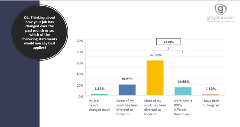What has happened to healthcare marketing in light of the COVID-19 pandemic? And where do we go from here as we consider the “new normal” in our industry?

These questions were on the mind of Mike Schneider, EVP and Principal at Greystone.Net, during his recent webinar on the results of Greystone’s survey on Healthcare Marketing During COVID-19. This survey provides a snapshot of healthcare marketing activities from early April 2020.
In his introductory remarks, Mike noted that many people outside of healthcare don’t realize that hospitals and healthcare systems are not making tons of money during the pandemic. That is largely because they don’t understand the mechanics of hospital finances and they think every hospital must be full. If hospitals are full, they’re making money, right? While we know that’s not true and why, it is the prevailing view of many outside the industry.
About a week into the shelter-in-place mandates, Greystone decided to survey hospitals and health systems to ascertain the effect of the pandemic on hospitals, health systems and healthcare marketing efforts.
The survey was conducted as part of Greystone Engage, a membership group for healthcare professionals with responsibility for web development, web management, social media, digital marketing, data management, CRM, analytics, communications, public relations, market research, business development and other related areas. Engage provides an aggregate perspective of what’s going on in healthcare marketing across the country, across various types of provider settings.
The survey launched for 10 days in early April. There were 139 respondents from various hospitals and health systems. (Vendors were excluded.) It was designed to learn more about how hospital and healthcare system marketing departments are handling the coronavirus outbreak and how it has impacted their everyday work.
Study Findings
As expected, the survey confirmed that COVID-19 has had a major impact on everyone, including hospitals and healthcare systems in the US. Detailed findings included:
- Over three-fourths of healthcare marketers (77%) have noted a major change in their duties. Within this group, 62% said that “most” of their work had been diverted to COVID-related efforts and almost 15% said their work is 100% different than it was pre-COVID.

- More healthcare organizations than not have diverted their marketing efforts completely away from non-COVID-related content and services (57% to 43%).
- This varies by type of organization. For example, over 75% of children’s hospitals, cancer centers and independent stand-alone hospitals (included specialty hospitals) have continued to market services unrelated to COVID.
- Of the organizations continuing to market non-pandemic services, 66.2% of respondents reported their non-pandemic marketing effort percentage as less than 10% to 25%.
- Larger organizations tended to focus less on non-pandemic services than smaller organizations.
- The top 5 communications/marketing roles – as reported by over two-thirds of the survey respondents - marketers have been actively involved with during the pandemic were:
- Communications with patients, visitors, consumers, etc. (93.4%)
- Updating/Revisiting/Revamping planned marketing activities (82.4%)
- Communications with employees and providers (79.1%)
- Developing COVID-19 documents, signage, tools, etc. (76.9%)
- Managing communications on social media channels (67%)
- Larger hospitals (>1000 beds) were more likely to spend time on helping their call center(s) prepare to handle increased call volumes than the respondent average.
- Larger systems were more likely to spend time creating/updating the organization’s strategic plan than the respondent average.
- Social media is by far the most-used marketing channel for communicating with patients and consumers, followed by email, written assets (e-Newsletters, brochures, magazines, direct mail, etc.) and blog posts. For survey respondents from larger hospitals (1000+ beds), 80% reported using shared interactive content, such as assessment tools, symptom checkers, chatbots, quizzers, etc.
- Social media is also by far the most effective communications channel for healthcare marketers during the pandemic, according to 84.62% of survey respondents. The next most effective channel was email marketing at 34%. The larger organizations who are using shared interactive content found it to be very effective (40%).
- About one-third of survey respondents reported they had stopped using both digital advertising and marketing research during the pandemic, and almost that many had stopped using patient testimonials (31%). Larger organizations were more likely to have also stopped written content (e-Newsletters, brochures, magazines, direct mail, etc.)

- When asked how much of their personal work activity had been redirected to COVID-19 activities, almost three-quarters (73.62%) of survey respondents said at least half of their workload was now focused on COVID-19. Almost one-third of respondents said 90% or more of their work efforts were for pandemic-related activities.
- Most marketing teams surveyed were primarily working remotely (90%). The teams working remotely were staying connected by:
- Email (96.34%)
- Video huddles via Zoom, GoToMeeting, etc. (85.37%)
- Phone conference calls (84.15%)
- Text messaging (73.17%)
- Tools like Slack, Jive, Microsoft Teams, etc. (50%)
- To communicate with employees and providers, survey respondents said their organizations were using primarily email (90.11%), followed by:
- Intranet updates (69.23%)
- Routine management phone/video huddles (65.84%)
- CEO/leadership video messaging (48.35%)
- e-Newsletter for employees (43.96%)
- Text messaging, dashboards, and blogs were used less frequently.
Respondents from children’s hospitals, cancer centers and rural hospitals tended to be more optimistic about the speed of a return to a pre-COVID status, while academic medical centers and health systems – regardless of size – predicted a slower return to “normal.”
In Summary:
- The pandemic has clearly changed how we work and what we do as healthcare marketers for now.
- Hospital marketers are updating/revisiting/revamping their marketing plans that were already in place.
- Social media has been the most used and the most effective tool in the healthcare marketing toolbox in the earlier days of the pandemic.
- Most marketing activity for hospitals is related to COVID-19.
- Nearly all marketing teams are working remotely and using various technologies to stay in communication with one another.
If you would like more detailed information about the results from Part I of our survey on the Pandemic Effect on Healthcare Marketers, you can download the report here. Part II of the survey looks at healthcare marketing efforts in early May 2020, one month after Part I. The survey is now available here.
If you would like more information about the survey or other information from Greystone, contact us at info@greystone.net or 770-407-7670.